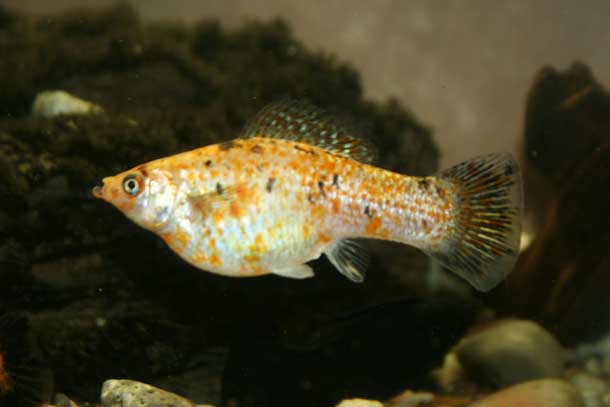The photo is of a mature female Pigeon Blood Sailfin Molly.
This is a domestic (commercial) molly strain we developed in 1999 while our hatchery was still in Santa Fe, New Mexico. The strain resulted from a cross of Poecilia latipinna, San Antonio River, a population of wild sailfins I collected in 1998 along the Riverwalk in downtown San Antonio, Texas with a strain of mollies we got from the Far East called Red Leopard Lyretail. We no longer have the Red Leopards, but their genes live on in our Pigeon Blood Sailfin and Pigeon Blood Lyretails.
The genesis of this strain was when I dropped a female Red Leopard Lyretail in with a male P. latipinna, San Antonio River. The resulting offspring were large, but not very colorful. They were flesh colored with a few black and orange freckles. Susie, my wife, took one look at them and said, “Discard them. They aren’t worth the space.” But, I saw some promise in the line. I kept a few of the lyretails and after a couple of generations had a fish I called “pigeon blood” because it reminded me of Pigeon Blood Discus. Apparently that strain of Discus was named such since it resembled dried blood flecks on flesh. Sort of gruesome.
I maintained the strain as lyretails, selecting for a silvery-flesh colored body with spangles of orange and black. After we moved to Texas, I outcrossed to Green Sailfin Mollies and selected for a non-lyretail strain.
The pictured female is one of our breeders. The strain requires constant selection to maintain the proper balance of background color and spangles. I selected a female to photo since males usually get all the attention. She shows that females can also be attractive in the aquarium.


Mujtaba ahmad says
How to feed babies of molly fish
How to feed in way so that they grow fast?
how to keep them in tank?
charles says
Mujtaba,
Mollies, like many aquarium fish, are grazers; that is they eat small amounts continuously through out the day rather than gorging. In an aquarium, I recommend feeding the fish small amounts every time you go by the tank. Watch how much they eat. If they don’t eat it all, try a smaller amount next time. If they eat it all and are still looking for food, try a bit more. After a while, you’ll be able to tell if they are hungry (mollies usually are!) and feed them just the amount they’ll eat right away.
Charles
Bella Crush says
Are the males just the pigeon blooded or can the females be also?
charles says
The females do usually show pigeon blood spotting, but not as much as the males.
charles
Bella Crush says
I do water changes and a week later the water is cloudy again.I do leave newborn babies in tank.Dont agree with the breeder boxes.
charles says
Cloudy water is usually caused by bacteria. Bacterial growth is fostered by overfeeding. I recommend feeding frequently, but only what is eaten immediately. Try feeding three to four times a day but only what is eaten before the food reaches the bottom. If your fish don’t show interest in the food, you are overfeeding.
Charles
Bella Crush says
Thank you Charles.Overfeeding.That makes sense.Because I feed them a ” snack”at night,But they still act hungry,So I will put more and more in.
charles says
Bella,
Feeding often is fine as long as they eat it all quickly.
Charles